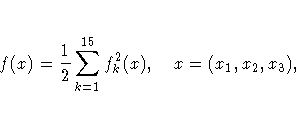Chapter Contents
Previous
Next
|
Chapter Contents |
Previous |
Next |
| The NLP Procedure |
This example illustrates the use of the DATA= option. The Bard function (refer to More et al. 1981) is a least-squares problem with n=3 parameters and m=15 functions fk:

The following is the naive way of specifying the objective function.
proc nlp tech=levmar; lsq y1-y15; parms x1-x3 = 1; tmp1 = 15 * x2 + min(1,15) * x3; y1 = 0.14 - (x1 + 1 / tmp1); tmp1 = 14 * x2 + min(2,14) * x3; y2 = 0.18 - (x1 + 2 / tmp1); tmp1 = 13 * x2 + min(3,13) * x3; y3 = 0.22 - (x1 + 3 / tmp1); tmp1 = 12 * x2 + min(4,12) * x3; y4 = 0.25 - (x1 + 4 / tmp1); tmp1 = 11 * x2 + min(5,11) * x3; y5 = 0.29 - (x1 + 5 / tmp1); tmp1 = 10 * x2 + min(6,10) * x3; y6 = 0.32 - (x1 + 6 / tmp1); tmp1 = 9 * x2 + min(7,9) * x3; y7 = 0.35 - (x1 + 7 / tmp1); tmp1 = 8 * x2 + min(8,8) * x3; y8 = 0.39 - (x1 + 8 / tmp1); tmp1 = 7 * x2 + min(9,7) * x3; y9 = 0.37 - (x1 + 9 / tmp1); tmp1 = 6 * x2 + min(10,6) * x3; y10 = 0.58 - (x1 + 10 / tmp1); tmp1 = 5 * x2 + min(11,5) * x3; y11 = 0.73 - (x1 + 11 / tmp1); tmp1 = 4 * x2 + min(12,4) * x3; y12 = 0.96 - (x1 + 12 / tmp1); tmp1 = 3 * x2 + min(13,3) * x3; y13 = 1.34 - (x1 + 13 / tmp1); tmp1 = 2 * x2 + min(14,2) * x3; y14 = 2.10 - (x1 + 14 / tmp1); tmp1 = 1 * x2 + min(15,1) * x3; y15 = 4.39 - (x1 + 15 / tmp1); run;
A more economical way to program this problem uses the DATA= option to input the 16 terms in f(x).
data bard; input r @@; w1 = 16. - _n_; w2 = min(_n_ , 16. - _n_); datalines; .14 .18 .22 .25 .29 .32 .35 .39 .37 .58 .73 .96 1.34 2.10 4.39 ; proc nlp data=bard tech=levmar; lsq y; parms x1-x3 = 1.; y = r - (x1 + _obs_ / (w1 * x2 + w2 * x3)); end;
Another way you can specify the objective function uses the ARRAY statement and an explicit do loop, as in the following code.
proc nlp tech=levmar;15] .14 .18 .22 .25 .29 .32 .35 .39 .37 .58
.73 .96 1.34 2.10 4.39 ;15] y1-y15;
lsq y1-y15;
parms x1-x3 = 1.;
do i = 1 to 15;
w1 = 16. - i;
w2 = min(i , w1);
w3 = w1 * x2 + w2 *i] = (x1 + i];
end;
run;
|
Chapter Contents |
Previous |
Next |
Top |
Copyright © 1999 by SAS Institute Inc., Cary, NC, USA. All rights reserved.